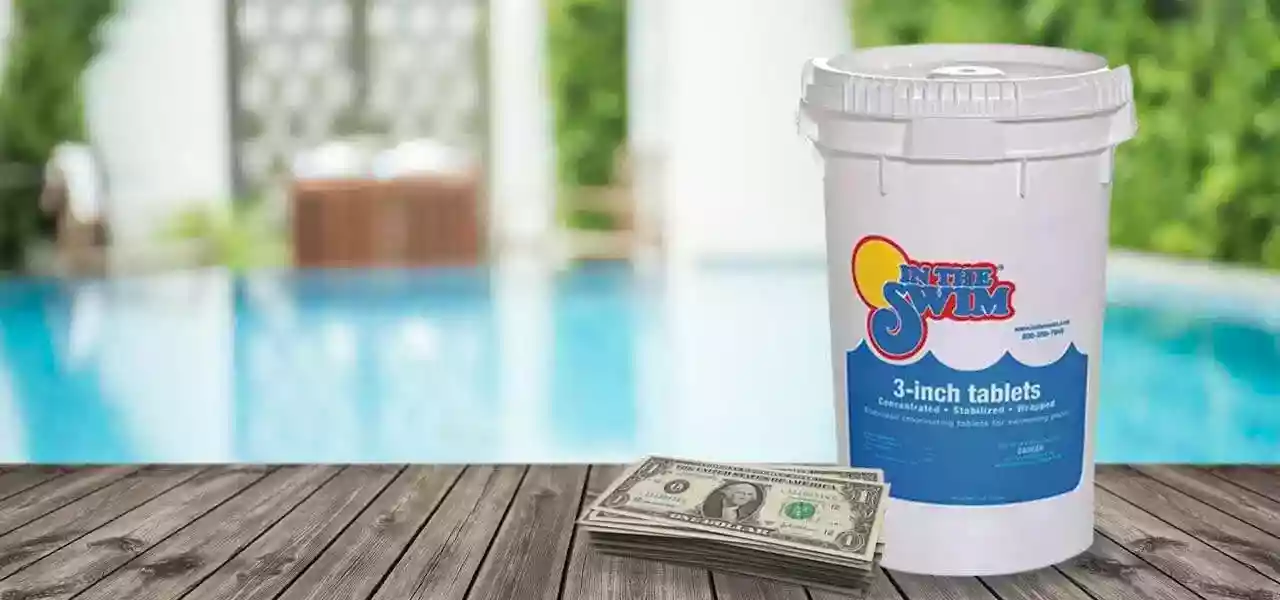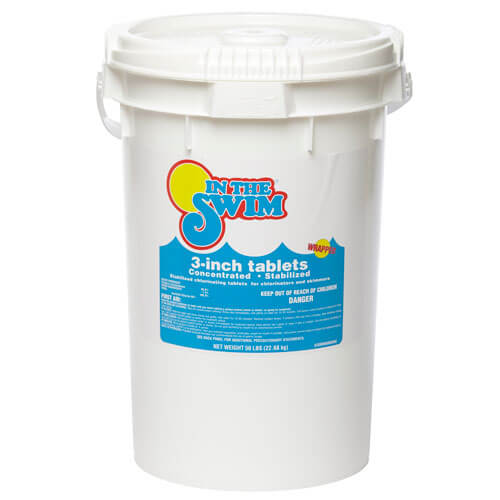FREE Standard Shipping On All Orders $100 or More!*

5 Ways to Extend Your Chlorine Dollar
Saving money by cutting back on monthly bills can be a challenging task. Nobody wants to give up their daily lattes or multiple movie streaming subscriptions! But sometimes sacrifices must be made. That being said, cutting back on chlorine use in your pool is not something you should do. Your pool needs chlorine in order to stay clean and healthy. However, there are ways to reduce chlorine costs, while still ensuring your pool receives the necessary amount of chlorine.
1. Test Pool Water Regularly to Lower Chlorine Costs
Let’s start with the easy one, testing your pool water. Test your pool daily — or at least weekly — with reliable test kits or strips. You will save yourself a headache by catching potential water chemistry issues before they get out of hand. It will also cut down on your chlorine cost! Unbalanced chemicals will inevitably cause chlorine to get out of whack, requiring you to use more and more chlorine to keep your pool sanitized.
Always keep your pool water chemical levels between the following ranges:
- pH: 7.4–7.6
- Total Alkalinity: 80–120 ppm
- Cyanuric Acid: 30–50 ppm
- Calcium Hardness: 200–400 ppm
2. Use Stabilized Chlorine to Lower Chlorine Costs
If you have an outdoor pool, you should use stabilized chlorine. What is stabilized chlorine, you ask? The word stabilized refers to whether or not the chlorine contains Cyanuric Acid, also known as water conditioner. Cyanuric Acid is like sunscreen for your chlorine. The sun's UV rays can destroy almost 90% of the chlorine in your pool in just 2 hours. Don't dump hundreds of dollars of chlorine into your pool, only to have it gobbled up by the sun. Using stabilized chlorine kills two birds with one stone. The chlorine sanitizes your pool, and the Cyanuric Acid protects the chlorine. It's an unbeatable combination!
Can you guess what unstabilized chlorine is missing from its ingredients list? If you said Cyanuric Acid, you're right. Unstabilized chlorine is just as effective at sanitizing your pool as stabilized chlorine, but it doesn't come with built-in sun defense. Using unstabilized chlorine in an outdoor pool is not necessarily the wrong choice, but it puts your chlorine and pool at risk. If you choose to use unstabilized chlorine, make sure to get a water conditioner, so you can keep chlorine costs down by extending its longevity.
Read the Label
When looking at the chlorine label, check how much available chlorine is present. Only purchase chlorine that contains at least 90% available chlorine. Anything lower than that is essentially diluted chlorine. Lower grade chlorine will likely be cheaper per pound, but remember that you will likely go through more of it quicker because it doesn't have a high enough chlorine concentration.
3. Use Alternative Sanitizing Methods to Lower Chlorine Costs
Buying the proper grade of chlorine is not the only way to stretch your dollar and lower chlorine cost. Boost your chlorine by incorporating a mineral purification system into your pool. Mineral purification systems are one of the only ways to not only reduce chlorine cost, but also decrease chlorine use. Mineral purifiers use copper and/or silver to sanitize the water and remove organic contaminants. The addition of these mineral helpers can lower the amount of chlorine needed by 0.5 ppm. Mineral purification systems may be pricey upfront, but each cartridge lasts 6 months, which will save you money on monthly chlorine cost.
4. Eliminate Organic Contaminants to Lower Chlorine Costs
Another way to trim chlorine cost is by eliminating organic contaminants in your pool water. Organic contaminants are human or environmental byproducts, such as sunscreen, body oils, cosmetics, sweat, and pollen. They can wreak havoc on your pool's sanitation system if left unchecked.
Because chlorine is not effective at breaking down and eliminating organics, adding an enzyme-based product to your cleaning regiment is the best way to clear your pool of organics. Most enzyme-based products also contain a phosphate remover. Phosphates are the main food source for every pool owner's worst nightmare — algae. Natural Chemistry's Pool Magic + PHOSfree expertly breaks down organic contaminants into water and carbon dioxide elements, rendering them harmless to your pool's health.
5. Filter Pool Water to Lower Chlorine Costs
Sanitization, circulation, and filtration are the three pillars of pool health. Without adequate amounts of each, your pool and pool water are at risk for bacteria growth, structural staining, chemistry imbalance, and numerous other problems.
Using a high quality sanitizer, like chlorine, and maintaining proper water chemistry balance will only help so much if your water is not being filtered or circulated properly. Increase your pool's filter and pump productivity by...
Improve Pool Water Circulation
- Adjust suction valves to draw in water from all areas of your pool.
- Brush and vacuum the pool regularly.
- Routinely clean the skimmer and pump baskets.
- Backwash the filter when the pressure gauge reads above ~30 psi.
Improve Pool Water Filtration
- Invest in an automatic pool cleaner or vacuum system.
- Regularly clean the pool filter.
- Run the filter for at least 8 hours each day.
- Backwash the filter when the pressure gauge reads above ~30 psi, or after vacuuming your pool.
- Use a water clarifier to help filter fine particles.
Saving money often requires sacrifice. Like making coffee at home instead of getting it from that expensive coffee shop down the street. Thankfully, there are many ways to decrease pool expenses without cutting quality or efficacy. Keep your chlorine costs low by implementing the methods detailed in the post.
Lower chlorine costs mean more money in your pocket! Which will make you feel less guilty about ordering that overpriced latte.
